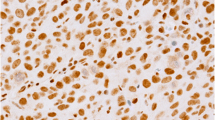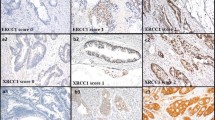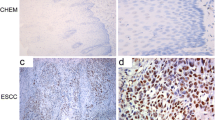Abstract
DNA double-strand break (DSB) is one of the most serious forms of damage induced by ionizing irradiation and is mainly repaired by the non-homologous end joining (NHEJ) repair. Immunohistochemical analysis of proteins involved in NHEJ, such as XRCC4 (X-ray repair cross-complementing protein 4), Ku86 and DNA-PKcs (DNA-dependent protein kinase, catalytic subunits), may be useful for predicting tumor radiosensitivity. We examined 92 patients with esophageal squamous cell carcinoma (ECSS) who were treated by radiotherapy between 1999 and 2008. Immunohistochemical examination of tumor tissue for Ki-67 and DSB-related proteins, including XRCC4, Ku86, and DNA-PKcs, was performed using pretreatment biopsy specimens. Low expression of XRCC4 was detected in 31 of 92 examined samples (33.7 %). The 5-year overall survival (OS) rate was 67.7 % in the low expression group and 31.0 % in the high expression group (P = 0.00). Multivariate analysis confirmed that advanced T-stage (HR 3.24, P = 0.01), radiation dose less than 66 Gy (HR 2.23, P = 0.02), absence of systemic chemotherapy (HR 2.59, P = 0.05), and high expression of XRCC4 (HR 12.0, P = 0.02) were independent prognostic factors for predicting poor OS. Other DSB-related proteins and Ki-67 were not predictive factors. XRCC4 expression might have an influence on results of radiotherapy for patients with ESCC.



Similar content being viewed by others
References
Ando N, Iizuka T, Ide H, Ishida K, Shinoda M, Nishimaki T, Takiyama W, Watanabe H, Isono K, Aoyama N, Makuuchi H, Tanaka O, Yamana H, Ikeuchi S, Kabuto T, Nagai K, Shimada Y, Kinjo Y, Fukuda H, Japan Clinical Oncology Group (2003) Surgery plus chemotherapy compared with surgery alone for localized squamous cell carcinoma of the thoracic esophagus: a Japan Clinical Oncology Group Study–JCOG9204. J Clin Oncol 21:4592–4596
Udagawa H, Ueno M, Shinohara H, Haruta S, Kaida S, Nakagawa M, Tsurumaru M (2012) The importance of grouping of lymph node stations and rationale of three-field lymphoadenectomy for thoracic esophageal cancer. J Surg Oncol 106:742–747
Hironaka S, Ohtsu A, Boku N, Muto M, Nagashima F, Saito H, Yoshida S, Nishimura M, Haruno M, Ishikura S, Ogino T, Yamamoto S, Ochiai A (2003) Nonrandomized comparison between definitive chemoradiotherapy and radical surgery in patients with T2–3Nany M0 squamous cell carcinoma of the esophagus. Int J Radiat Oncol Biol Phys 57:425–433
Blazeby MJ, Farndon RJ, Donovan J, Alderson D (2000) A Prospective Longitudinal Study Examining the Quality of Life of Patients with Esophageal Carcinoma. Cancer 88:1781–1787
American Society of Clinical Oncology, Pfister DG, Laurie SA, Weinstein GS, Mendenhall WM, Adelstein DJ, Ang KK, Clayman GL, Fisher SG, Forastiere AA, Harrison LB, Lefebvre JL, Leupold N, List MA, O’Malley BO, Patel S, Posner MR, Schwartz MA, Wolf GT (2006) American Society of Clinical Oncology clinical practice guideline for the use of larynx-preservation strategies in the treatment of laryngeal cancer. J Clin Oncol 24:3693–3704
Tachimori Y, Kanamori N, Uemura N, Hokamura N, Igaki H, Kato H (2009) Salvage esophagectomy after high-dose chemoradiotherapy for esophageal squamous cell carcinoma. J Thorac Cardiovasc Surg 137:49–54
Hall EJ (2006) DNA strand breaks and chromosomal aberrations. In: Hall EJ, Giaccia AM (eds) Radiobiology for the Radiologist, 6th edn. Lippincott Williams & Wilkins, Philadelphia, pp 16–29
Polo SE, Jackson SP (2011) Dynamics of DNA damage response proteins at DNA breaks: a focus on protein modification. Genes Dev 25:409–433
Kamdar RP, Matsumoto Y (2010) Radiation-induced XRCC4 association with chromatin DNA analyzed by biochemical fractionation. J Radiat Res 51:303–313
Okuno Y, Nishimura Y, Kashu I, Ono K, Hiraoka M (1999) Prognostic values of proliferating cell nuclear antigen (PCNA) and Ki-67 for radiotherapy of oesophageal squamous cell carcinomas. Br J Cancer 80:387–395
Sato Y, Takayama T, Sagawa T, Okamoto T, Miyanishi K, Sato T, Araki H, Iyama S, Abe S, Murase K, Takimoto R, Nagakura H, Hareyama M, Kato J, Niitsu Y (2006) A phase I/II study of nedaplatin and 5-fluorouracil with concurrent radiotherapy in patients with esophageal cancer. Cancer Chemother Pharmacol 58:570–576
Someya M, Sakata K, Saito A, Nagakura H, Oouchi A, Hareyama M (2002) Results of external irradiation and low-dose-rate intraluminal brachytherapy for esophageal cancer. Acta Oncol 41:63–68
Hayashi J, Sakata K, Someya M, Matsumoto Y, Satoh M, Nakata K, Hori M, Takagi M, Kondoh A, Himi T, Hareyama M (2012) Analysis and results of Ku and XRCC4 expression in hypopharyngeal cancer tissues treated with chemoradiotherapy. Oncol Lett 4:151–155
Kuwano H, Nishimura Y, Oyama T, Kato H, Kitagawa Y, Kusano M, Shimada H, Takiuchi H, Toh Y, Doki Y, Naomoto Y, Matsubara H, Miyazaki T, Muto M, Yanagisawa A (2015) Guidelines for diagnosis and treatment of carcinoma of the esophagus April 2012 edited by the Japan Esophageal Society. Esophagus 12:1–30
Tsuchimoto T, Sakata K, Someya M, Yamamoto H, Hirayama R, Matsumoto Y, Furusawa Y, Hareyama M (2011) Gene expression associated with DNA-dependent protein kinase activity under normoxia, hypoxia and reoxygenation. J Radiat Res 52:464–471
Hadjiliadis N (2009) Platinum drugs, nucleotides, and DNA: the role of inter ligand interactions, nucleotides and DNA. In: Hadjiliadis N, Sletten E (eds) Metal complex-DNA interactions. Wiley-Blackwell, USA, pp 174–209
Beskow C, Kanter L, Holgersson A, Nilsson B, Frankendal B, Avall-Lundqvist E, Lewensohn R (2006) Expression of DNA damage response proteins and complete remission after radiotherapy of stage IB–IIA of cervical cancer. Br J Cancer 94:1683–1689
Xing J, Wu X, Vaporciyan AA, Spitz MR, Gu J (2008) Prognostic significance of Ataxia- Telangiectasia mutated, DNA-dependent protein kinase catalytic subunit, and Ku heterodimeric regulatory complex 86-kD subunit expression in patients with nonsmall cell lung cancer. Cancer 112:2756–2764
Söderlund Leifler K, Queseth S, Fornander T, Askmalm MS (2010) Low expression of Ku70/80, but high expression of DNA-PKcs, predict good response to radiotherapy in early breast cancer. Int J Oncol 37:1547–1554
Someya M, Sakata K, Matsumoto Y, Satoh M, Narimatsu H, Hareyama M (2007) Immunohistochemical analysis of Ku70/86 expression of breast cancer tissues. Oncol Rep 18:1483–1487
Komuro Y, Watanabe T, Hosoi Y, Matsumoto Y, Nakagawa K, Tsuno N, Kazama S, Kitayama J, Suzuki N, Nagawa H (2002) The expression pattern of Ku correlates with tumor radiosensitivity and disease free survival in patients with rectal carcinoma. Cancer 95:1199–1205
Master R, DePinho R (2002) Connecting chromosomes, crisis, and cancer. Science 297:565–569
Dorr W (2009) Pathogenesis of normal-tissue side-effects. In: Joiner M, Van der Kogel A (eds) Basic clinical radiobiology, 4th edn. Hodder Arnold, UK, pp 169–190
Acknowledgments
The research was supported in part by a Grant in Aid for Scientific Research from the Ministry of Education, Culture, Sports, Science and Technology, Japan. I would like to thank Dr. Masanori Nojima (The Institute of Medical Science Hospital, The University of Tokyo) for useful advices about statistical analysis.
Author information
Authors and Affiliations
Corresponding author
Rights and permissions
About this article
Cite this article
Hori, M., Someya, M., Matsumoto, Y. et al. Influence of XRCC4 expression in esophageal cancer cells on the response to radiotherapy. Med Mol Morphol 50, 25–33 (2017). https://doi.org/10.1007/s00795-016-0144-5
Received:
Accepted:
Published:
Issue Date:
DOI: https://doi.org/10.1007/s00795-016-0144-5




